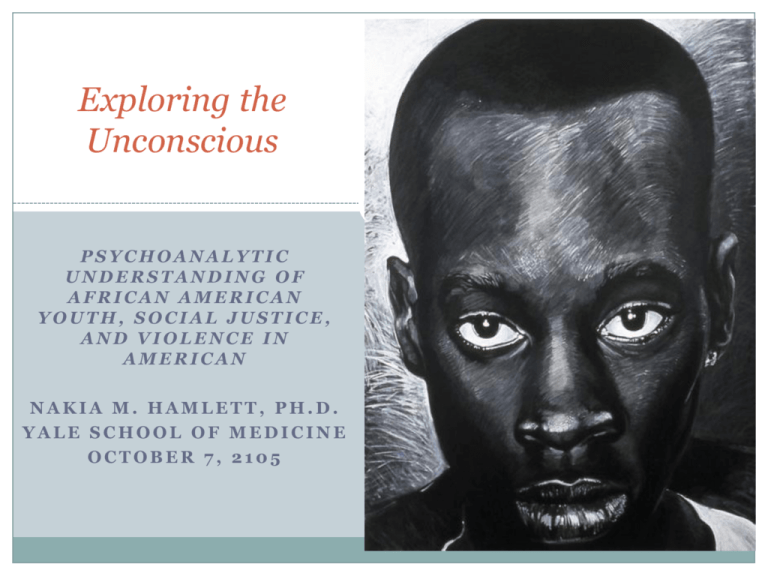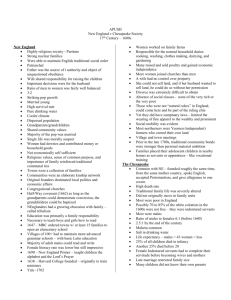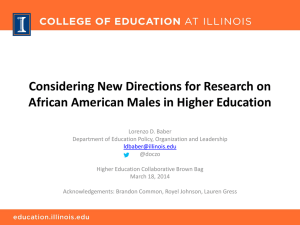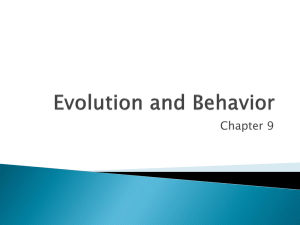clicking here - Rhode Island Association for Psychoanalytic
advertisement

Exploring the Unconscious PSYCHOANALYTIC UNDERSTANDING OF AFRICAN AMERICAN YOUTH, SOCIAL JUSTICE, AND VIOLENCE IN AMERICAN NAKIA M. HAMLETT, PH.D. YALE SCHOOL OF MEDICINE OCTOBER 7, 2105 Overview Introduction Sociocultural Context Statistics Conceptual Models Parenting Issues & Attachment Policing Conclusions Learning Objectives At the conclusion of this workshop, participants will be able to better: Understand the ways in which institutional and historic forms of cultural marginalization, racism, and prejudice impact on African American youth and families. Understand conceptual models of racial and social identity development specific to African American males. Understand the implications of trauma exposure on the cultural, identity, and psychic development in African American males. Plan and implement more culturally-sensitive and developmentally appropriate psychotherapy interventions for African American males. Free Associations 1. What is your sense of current race relations and prejudice in America? 2.What are some of your ideas, biases, about AA youth? 3.What was your initial reaction to incidents like Ferguson and the killing of black youth? 4. How do you view yourself in relation to AA youth? 5.What are some statistics/facts you know about outcomes for African American youth? Free Associations What are you afraid or embarrassed for people to know about how you: Think about black males Feel about black males Expect black males to behave And any other biases Points to Consider Barriers to accepting on an EMOTIONAL level that: 1. Blacks have been traumatized by their experiences in contemporary America 2. Separate but equal has not yet happened 3. Whites have privileges and opportunities that the average black person may not 4. Maintenance of the status quo benefits whites and hurts blacks 5. These facts may greatly influence how a white clinician experiences (and helps) a black patient How Do We Move Past: White guilt Denial Impartiality Other defensive postures Blaming the victim Reaction formation Sublimation African American Youth, Social Justice & Violence “I hadn't cried in years, but the morning after the decision to not charge Darren Wilson was a lonesome, teary one. I teared up while ironing my clothes for these brothas who died and who were getting further devalued and disrespected post mortum. We've paid our dues and protected this nation in every conflict in American history, but still racism trumps patriotism. Black men remain in a defensive posture, targeted by our tax paid protectors in the name of fear, treated as if this isn't really our country, never quite sure that our skin color and hair texture won't get us in trouble. ” Robert Graham, Ph.D. student in Education (and one of my dearest friends) It’s Hard Not to Know “It starts with the “click, click, click” of car doors locking as you pass by. It continues with the quick look over the shoulder glance, to see if you’re a safe distance away. It’s noticed when shoppers squeeze shoulder bags and pocketbooks to their bodies like birds protecting their young. You know people fear you because of who you are-young & black” (Green, 2014, p. 287) Racist experiences become a self-fulfilling prophecy that creates a sense of failure & poor self-worth”-a culture of failure & isolation” (Alonso, 2014, p. 25) Negative identity popularized in the media, mainly through hip-hop, becomes the easiest to identify with & internalize Glorification of “ghetto life” suggests a lack of choices & options for urban black youth. Sociocultural Context African Americans confused about racism in 5 ways: Rejecting the genuine positive regard & support from Whites may be as great an error as trusting a EA who harbors racist, negative stereotypes African Americans can’t tell “who’s who” Hard to know if one is being tolerated or genuinely accepted by EAs AA have difficulty distinguishing between supportive efforts of individual EAs & destructive actions of EAs as a group Hard to know when, where, & how to resist oppression, and when to ignore or bear it Hard to know when you are in control of your destiny vs when there are some external factors, visible & invisible, at play that prevent you being in control Sociocultural Context Social Capital Ethnic group status depends on stability of privilege and acquisition in this country Individual status depends on overall group status Individual vulnerability tied to group vulnerability Networks of support in places of power Make opportunities more readily available Levels of Racism Individual Institutional Cultural Sociocultural Context Racial context: Shift from industrial to technological & service-based economy disproportionately affected BMs BMs left with low-paying, dead-end jobs in poor inner cities (Zinn, 1989) Welfare system only provided financial support to unmarried women (Blau et al., 2004) Real estate and financial bias lead to decreased opportunity to obtain mortgages and business loans (Blank et al., 2006) Leads to unofficial segregation (Bates et al.,2005) Substandard housing, environmental hazards (Ringquest, 2005) Substandard educational opportunities Includes the assumption of inferiority and lack of access to & advancement in institutes of higher education Sociocultural Context Legal System Jury bias (Schroeder et al., 2005) Unfair mandatory sentences for nonviolent crimes (Free, 1997) Racial profiling by police (Hayes, 2000) Overwhelming disproportionate incarceration (Bureau of Justice Statistics, 2006) Overrepresentation in the juvenile justice and child welfare systems Racial bias in the subjective measures of child maltreatment (Berger, 2005) Health Risks (Anderson, 2004) Limited and inadequate access to health care Substandard food options due to costs and lack of adequate venues (urban food deserts) Heightened risk for diabetes, cardiovascular diseases, cancer, HIV/AIDS & poorer outcomes once diagnoses Mistrust of medical professionals/discriminatory practices toward blacks Psychiatric Impairment in AA Males Suicide rate among AA 4 times higher than among AA women Rates for various behavioral health outcomes higher among AA males African Americans have higher lifetime prevalence rates than Whites (National Comorbidity Study, 1996) African American males may be disproportionately diagnosed with schizophrenia or other psychotic disorders African American Males Violence and homicide leading causes of death Disproportionately incarcerated In 2005, 5% of black males incarcerated, more than twice the % of Latinos, and nearly 7x that as white males More blacks imprisoned today in America than in South Africa during apartheid (Speilberg, 2014) By late 20s, this rate goes up to 12% (B of Justice, 2006) 22% have record by age 30 Black males represent 50% of prison population 30% more males in prison than in universities (Justice Policy Institute, 2002) Black youth as young as 6 often have traumatizing experiences with police, community, and schools African American Males Heightened risk for a laundry list of problems: Developmental and learning delays School failure/expulsion 13.5% of black males age 16 to 24 are high-school drop-outs compared to 7% of white males 55% of high school AA males do not graduate with classmates, 25% disparity between black and white males (Holzman, 2006) Defined, described, and treated as “delinquent” Incarceration Injuries/accidents Homicide HIV/AIDS Life expectancy 6 years shorter than for white males School Issues By 4th grade (Holzman, 2006): Noticeable decline in academic achievement Denied access to gifted programs In part due to subjective ratings of teachers Black teachers tend to view black students’ behaviors more positively than white males (Downey et al., 2004) Black teachers less often place B students in spec ed & more often in gifted classes Black students 3x more likely to be placed in special ed, with white students 3x as likely to be placed in gifted classes Discrepancy perceptions of what school SHOULD be like and actual experiences leads to (White, 1999): Confusion Withdrawal from school Loss of confidence in academic competence School Issues By 4th grade: Black males make up 20.63% of students classified as mentally retarded 21.67% of “seriously emotionally disturbed” students 12.86% of those with specific learning disability Black students with disabilities 3.1 times more likely to receive shortterm suspension 2.56 times more likely to receive long-term suspension (Civil Rights Project, 2000) All stats disproportionate to 8.7% of students who are black males Teachers may begin to fear black male students & have lower expectations for their overall academic abilities (Roderick, 2003; Rong, 1996) As protection from the pain of teacher hostility & rejection some AA boys convince themselves that they don’t care about school & academic achievement & take on an oppositional “tough” persona stereotyped in the media (Schmader et al., 2001; Steele, 1997, Graham, 1997) Academic dis-identification School Issues “Feeling that one is damaged or can damage others is antithetical to the freedom to explore one’s thoughts including those on academic future. Consequently, many AA men close their minds to school; their attention spans suffer, and their thinking becomes less expansive as they struggle with the feeling that they must overcome impossible expectations to work against type. Their experiences in school take on the powerful voice of a new and critical parent, one that intrudes on their own thought processes.” (Spielberg, 2014, p. 59). Law Enforcement & AA Youth AA youth learn early that officers are not necessarily “friends” Proactive parents model or explicitly teach rules for appropriate youth engagement with police Whites and blacks have differing views on police Community interactions one-on-one in non-coercive situations lead to better perceptions & relationships Police Enforcement & African American Males “The policeman develops a perceptual short-hand to identify certain kinds of people as symbolic assailants, that is, as persons use gesture, language, & attire that the policeman has come to recognize as a prelude to violence…the policeman responds to these vague indications of danger suggested by appearance…the patrolman (in Westville and probably most communities, has come to identify the black man with danger” (Justice Without Trial: Law Enforcement in Democratic Society, Skolnick, 1993) Law Enforcement & AA Youth: Things to Consider “Something I don’t believe the white community understands yet is that, the object was to bring a black body in, not necessarily the person who committed the crime” Tennessee judge who overturned a conviction of black man accused of rape in 1960 (Jones-Brown, 2014) Tennessee vs. Garner (1985) Supreme court ruled police force limited use of deadly force to situations in which fleeing individuals are suspected of posing serious threat of death or serious physical injury to others Questions: How is “serious threat determined”? Is this statute routinely followed? Single Mothers & AA Males (Gant & Greif, 2014) Parenting Strategies to Protect Sons Shield from negative influences Help avoid harm Praying Educating Interpreting social phenomena Provide social support Connect to fathers or father figures Provide resources Set expectations Instill positive AA identity Promote responsibility Fathers & Black Males Historical Context Financial disparities & lack of opportunities make providing for family more challenging Fathers often had to leave families to travel to find work Legacy of slavery made black fathering ambiguous AA father was authoritative with children but the slave owner was the ultimate father (Blassingame, 1972) Modern Day Challenges Father absence in AA homes is a clear concern Bias in research may put negative spin on this issue Non-resident fathers may not have regular contact with children due to: Mental health issues or substance abuse problems Incarceration On-going conflict with mother/new family Lack of emotional & financial resources Racial Socialization AA Parents: Parenting strategies geared toward survival can racialize socialization Teach their kids they have to be, do, and look better Vary in level of acculturation & emphasis on education 3 forms of Adaptation Protective Proactive View world as distrustful & filled with racial hostility; learn caution and strategies for success despite circumstance Encouraged to focus on personal talent and cultural heritage, less on racial hostility Adaptive Integration of protective and proactive beliefs Black males integrate messages to form identity “You can be as much a man within the brotherhood of an AA community as you can be a “N” outside of it” Protective Factors Parents espousing cultural values, pride, and high educational standards Authoritative parenting Culturally sensitive education Constructive, prosocial peer group Natural non-parental mentors Learning effective strategies for conflict resolution Only supervised access to media Clear, flexible, perspectives on masculinity Help males have choices for identity other than negative stereotypes Attachment Problems in Black Males Afraid to think (Fonagy & Target, 1997) Link between hostility in others and children’s inability to develop self-awareness & advanced cognition When care-givers & authority figures are rejecting, hostile, or difficult to understand, young children become less open to understanding the minds of others This is an adaptive strategy of childhood victims of deprivation or rejection Truly understanding the hostile thoughts of an adult would be terrifying and overwhelming Closing minds to adults makes self-awareness limited They fear that their natural rebelliousness & self-assertion will prompt retaliation from adults Leads to under-developed capacity to symbolize and think abstractly about themselves and others • Undermines healthy separation, affective control and competence in various domains Identity Development Identity is achieved by “resolving the crises inherent in life choices and making purposeful decisions and stable commitments” (Frank, p. 23). Individuals develop goals and orientation toward education, work, and goals through an evolution of ideological and philosophical perspectives on the world and what is deemed possible Intersection of black personality and racism (Jones, 1991) Black personality based on cumulative reactions to racism and African cultural legacy Black personality reflects cumulative adaptation to racial discrimination, thus personality reflects changes in society Theories of black personality must account for: Diversity of adaptations to fundamental realities of racialism Coping has a profound impact on character development Internalized Oppression “It is a peculiar sensation, this double-consciousness, this sense of always looking at one’s self through the eyes of others, of measuring one’s soul by the tape of a world that looks on in amused contempt and pity”. —W.E.B. Du Bois, The Souls of Black Folks (1903) Black males may find it difficult to stand up to racist aggressions due to some belief that they are inferior and unworthy of better treatment When they do react, these reactions are often negative & counterproductive Capacity to be aware of racist actions is undermined by strong feelings of inferiority Black males may have absorbed sense of being dangerous to others, “lazy”, intellectually inferior Identity develops centered around internalized negative stereotypes Uneducated (school is not cool) Tough Ruthless, scheming, calculating, & relenting Mysogenistic Callous & unemotional Intrapsychic Factors: AA & The “Other” Black men experience conflicts about aggression & passivity because society does not allow them the healthy expression of aggression, self-assertion, & passivity (Douglas et al., 2014) Inappropriate channeling of aggressive drives & hostile feelings lead to various forms of psychopathology Id Stereotypes (Pettigrew, 1971) Black people are: Dangerous Dirty Covetous Aggressive Invisibility Syndrome Intrapsychic struggle for identity in black males related to encounters with racism 7 Principles One feels a lack of recognition or appropriate acknowledgement One feels there is no satisfaction or gratification from encounter One feels self-doubt about legitimacy (“Am I in the right place, should I be here? Do I belong?) No validation “Am I a person of worth”? One feels disrespected Ones sense of dignity is compromised and challenged One’s basic identity is shaken, if not uprooted Invisibility Syndrome “Judgments based on skin color make genuine character invisible” (Franklin, 2014) Dealing with prejudgmental views of character creates psychological tension and feelings of invisibility Psychoanalysis is designed to help a person be “known”, “validated” and “recognized” like never before (Gabbard, 2010) Requires the ability to see beyond preconceived notions May be more difficult with AA youth AA men feel that others do not really know them Invisibility Syndrome Clinical Evaluation to assess how the following interact in an intrapsychic manner to lead to visibility or invisibility Recognition Satisfaction Legitimacy Validation Respect Dignity Identity Invisibility Paradigm Ego Development and Racial Identity Less mature ego: derives self-image from external sources More mature ego: derives self-images from experience, exploration, & integration Stress occurs from trying to determine: What to change about behaviors to gain acceptance What is risked by being one’s self AA men struggle to determine how to accept themselves and be a person of AA descent in a culture where one’s group is a primary object of prejudice and discrimination Developmental tasks can be too challenging causing regression or take alternative paths to identity development If an individual makes a change with no positive result: Disillusionment sets in Confusion about appropriate road to acceptance Constant attempts at visibility and acceptance How, then, have black boys learned how to be “visible” in our society? Invisibility Paradigm Micro-aggressions (Pierce, 1988) “Verbal offensive mechanisms and nonverbal, sometimes kinetic offensive mechanisms that control ‘space, time, energy, and mobility of the Black, while producing feelings of degradation, and erosion of self-confidence and self-image” (p. 31) Micro-aggressions Subtle acts or attitudes experienced as hostile, which fit a personal history and pattern of racial slights and disregard Representations: history of racial slights help determine response & internalization/interpretation of events Covert assumptions in MA leads to: Blacks are confused about whether they are being tolerated or accepted Blacks are confused about the supportive effort of individual Whites vs. the destructive action by Whites as a collective Blacks are confused about when, where, and how to resist oppression vs when and how to accommodate it Invisibility Paradigm Black males have to struggle against society stereotypes or be victimized by their predetermination of his personal identity (Gordon et al., 1995) Most poor, uneducated black males do not have the environmental tools necessary to battle this MA and racial slights from subtle yet malevolent cross-racial interactions induce (1988): Disillusionment Confusion Chronic doubts about self and personal efficacy Invisibility Syndrome (Franklin, 2014) “Where the African American person positions him/herself, in terms of which identity traits he/she internalizes and how his position mediates his behavior in the world, is important to his resolution and management of challenges in his projection of himself as a man of African descent” (Franklin, p. 17) Racism manipulates the rules of conformity and inclusion Discerning racism and responding consistent with one’s self moves one toward visibility There is social pressure to assimilate and “tolerance”-not acceptance is the normative code of behavior of the dominant group Racist slights serve as “social status reminders” that are provocative, emotionally stressful, anxiety producing, and anger inducing deepens feelings of invisibility The term “mopes” (O Wright will explain) is one example The Brotherman Study (2001-Present) Designed to understand how black males interpret intrapsychic and interpsychic experiences N= 40, from all SES strata (Upper, middle, lowerclass in NY) Five important findings emerged: Transgenerational transmission of trauma underlies identity formation A greater understanding of new stereotypes about black males Differential attachment styles in families The impact of experienced racism on attachment styles at school Self-appraisal in relationship to media and law enforcement The Brotherman Study: Trying Not To Know Primary Defensive Strategy Contrary to expectations, findings suggest young black males try to avoid thinking about & seeing impact of racism on their lives When racist events happen they try to avoid conscious awareness until due to severity & over-load it becomes impossible to do so Findings showed that those who avoided more had worse outcomes vs those who developed and understanding and strategy for managing racial prejudice in their lives Selective inattention and worse dissociation are culturally prescribed Mainstream promotion of “color-blind society” suggests we care equally about all children When there is no control, people tend to overlook events & behaviors that they find troubling One Doctor’s Story: Dr. Geoffrey Moorer Implications for Psychotherapy Understanding relevant theories of identity is critical to determining the stage & perspective of the patient Clinical goals in a group include: Helping male patient voice his concerns and views on life as a black man in American society Helping him become aware that his life experiences are reflections of issues experienced by other black men Providing one another with support and suggestions Build on the significance and symbolism of a “circle” in African American culture Understanding of their experiences with racism and challenges to their dignity and respect Understand the trust issues, confusion, and paranoia caused by repeated experiences of racism will impact therapy and it may take longer to build rapport Black men will be challenging to engage because: Talking to others about personal life struggles goes against gender codes of survival (Anderson, 1990) Revealing vulnerability threatens personal image and alters necessary power alignments between men Implications for Psychotherapy AA men must be encouraged to “know” and understand the hostility and racism directed toward them in order to develop resilience and coping strategies Help AA develop a “psychic shield” against “slings and arrows” of racism Develop within psychoanalysis a “language” & framework to discuss race and ethnicity Lack of critical mass of people of color contributes to the problem but psychoanalytic clinicians must be innovative & creative in their work with people of color CONCLUDING COMMENTS/THOUGHTS Changes in opinions or perceptions about American society and black males Feelings evoked by these statistics and facts about black males Connections to personal experiences with black male Thoughts on how these facts relate to current events








